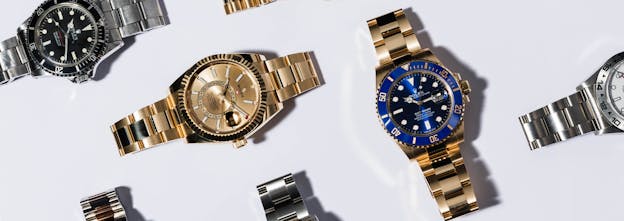A Peek Ahead: The Trajectory of the Rolex Watch Market
Twenty years ago, the Rolex collector landscape was vastly different. Picture this—a 1999 auction catalog featured a handful of watches including a black ref. 6238 pre-Daytona chronograph, two screw down Daytona manual winds, and two non-screw down Paul Newmans. The black ref. 6238 didn’t sell, the screw down non-Paul Newman’s made about $4,000 a piece, and the Paul Newman’s made about $8,500 a piece. In total, you could have purchased all three of these pieces together for about $30,000. Today, they would ring in at around $1,000,000.
According to a The 1916 Company discussion with Rolex scholar James Dowling, social media and changes in fashion have played a huge role in the brand’s evolution. Particularly, brand ambassadors and “influencers” have dictated a demand for GMTs, Daytonas, and Submariners in the last several years—but we can’t get too comfortable. Dowling describes Rolex trends as a moving target. For example, there are people collecting the early sapphire glass Submariners with matte dials which are now considered highly collectible. Years ago, this wasn’t the case. Perhaps the best way to frame it, according to Dowling, is to say “There’s a sheep mentality. People want stuff because they can’t have it.”

And by all accounts, that has some merit. However, not every watch has skyrocketed in demand and price over the last 20 years. In the mid-to late 1990s, the most valuable Rolex you could buy was a steel Rolex Hooded Bubble Back which sold at a minimum of $40-50,000. That watch today would likely not break $15,000. Funny how that works, right?
“The truth is that some stuff has gone up a lot which everybody wants to talk about. But what nobody seems to want to talk about is that a lot of stuff has actually gone down,” says Dowling.
Perhaps another key reason as to why Rolex prices have experienced these ebbs and flows is due to how we’ve changed the way their value is measured. Over time, intangible markers and arbitrary distinctions like the Bart Simpson crown or the first 6-digit Sub have been overhyped by the vintage market. There are now swaths of collectors who spend their time looking at nuanced differences between bezels, dials, or bracelets and monetize it—one minute someone notices a small difference that wasn’t previously talked about, and the next minute the price and demand fluctuates.
“There is absolutely no logic in this business whatsoever. It’s about emotion, it’s about desire, it’s about the herd mentality,” Dowling reiterates.
But, maybe you need another example to see how truly nonsensical these trends are. According to A Blog to Watch’s incredible analysis of “How And Why Rolex Prices Have Increased Over Time,” today’s Submariner no-date is nearly six times more expensive than it “should” be after factoring in inflation. So, let’s break it down.
Tracing the Submariner no-date pricing back to 1957, we know that it has remained a popular tool watch compared to other pieces of its kind. Today, modern iterations of the model have improved on design, equipping it for an office setting as opposed to its traditional diving intention. Other enhancements over the years have included the addition of a more comfortable bracelet and luminescent material—and because of this, we have seen prices rise over the past 60 years. But do these improvements constitute the current cost? In 1957, a Submariner no-date cost $150. With inflation, that price would equate to about $1,265 as of 2014. However, today, this piece costs around $7,500—yes, you read that right. It’s about six times more expensive than it “should” be, and there’s no end in sight for this spike…no matter how many new gizmos they add or subtract from it.
On the other hand, models like the Rolex Daytona have undergone similar upgrades over the years—new in-house movements, small aesthetic tweaks, you name it. But after running the same inflation calculation, the Rolex Daytona is not six times more expensive than it should be. Taking a look at these seemingly bizarre trends, we think much of this has to do with the topic we touched on earlier—and it boils down to influencers, style shifts, and new markers of value that seem to fall out of thin air.
So, where does the Rolex watch market go from here? In short, no one really knows. Dowling describes Rolex collecting as a zero sum game, and oftentimes, people use the brand as their, for lack of a better term, “gateway drug” into luxury watches. According to the Robb Report, Rolex accounts for a whopping 25% of all Swiss watch sales, with Omega trailing behind in second, so there’s no surprise as to why “the king” is top of mind for many. Typically, someone will buy a Rolex, then phase out of it as they discover and study other big name brands. Then, after some years pass, they come back to Rolex because they know they can trust its durability, value, and craftsmanship. A force to be reckoned with, one never has to worry about ruining a Rolex with everyday wear. It’s safe to say they’re going to stick around.
With that being said, if collectors continue to phase in and out of the brand, we can predict with some certainty that a pretty curvaceous trajectory chart is being crafted as we speak. Want a glimpse at what this might look like? Keep an eye on the secondary market value of these rare and revered Rolex models over time. Or, gather more detailed data from WatchPro’s article, “Rolex prices continue to rocket on secondary market.”

